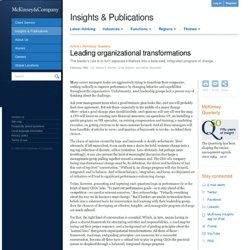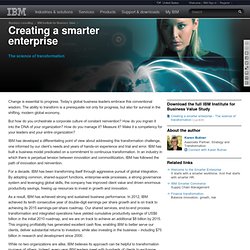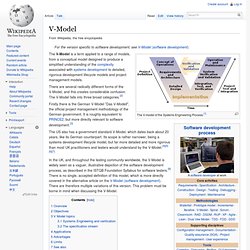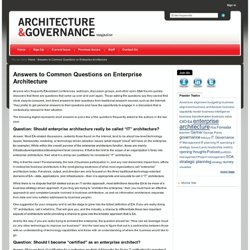

How to avoid the three common execution pitfalls that derail automation programs. Automation has great potential to create value—but only for businesses that carefully design and execute it.

Encouraged by the much-vaunted potential of automation, organizations around the world are embarking on their own transformation journeys. On paper, the numbers look compelling. The McKinsey Global Institute estimates that about half the activities that workers are paid $15 trillion in wages to perform in the global economy have the potential to be automated by taking advantage of current technologies (see sidebar, “Key automation technologies”). Looked at another way, at least 30 percent of work activities in about 60 percent of all occupations could, in principle, be automated.
Sidebar Key automation technologies. Ten Reasons People Resist Change - Rosabeth Moss Kanter. By Rosabeth Moss Kanter | 12:00 PM September 25, 2012 Leadership is about change, but what is a leader to do when faced with ubiquitous resistance?

Resistance to change manifests itself in many ways, from foot-dragging and inertia to petty sabotage to outright rebellions. The best tool for leaders of change is to understand the predictable, universal sources of resistance in each situation and then strategize around them. Here are the ten I’ve found to be the most common. Loss of control. Excess uncertainty. Surprise, surprise! Everything seems different. Loss of face. Concerns about competence.
More work. Leading organizational transformations. Many senior managers today are aggressively trying to transform their companies, seeking radically to improve performance by changing behavior and capabilities throughout the organization.

Unfortunately, most leadership groups lack a proven way of thinking about the challenge. Ask your management team what a good business plan looks like, and you will probably find close agreement. But ask them—especially in the middle of a major change effort—what a good change plan should include, and opinions will vary all over the map. A CFO will insist on creating new financial measures; an operations VP, on installing a quality program; an HR specialist, on revising compensation and training; a marketing executive, on getting everyone to be more customer focused. Change leader, change thyself. Leo Tolstoy, the Russian novelist, famously wrote, “Everyone thinks of changing the world, but no one thinks of changing himself.”

Tolstoy’s dictum is a useful starting point for any executive engaged in organizational change. After years of collaborating in efforts to advance the practice of leadership and cultural transformation, we’ve become convinced that organizational change is inseparable from individual change. Simply put, change efforts often falter because individuals overlook the need to make fundamental changes in themselves. Building self-understanding and then translating it into an organizational context is easier said than done, and getting started is often the hardest part.
We hope this article helps leaders who are ready to try and will intrigue those curious to learn more. Organizations don’t change—people do Many companies move quickly from setting their performance objectives to implementing a suite of change initiatives. Creating a smarter enterprise. Change is essential to progress.

Today’s global business leaders embrace this conventional wisdom. The ability to transform is a prerequisite not only for progress, but also for survival in the shifting, modern global economy. V-Model. The V-model of the Systems Engineering Process.[1] The V-Model is a term applied to a range of models, from a conceptual model designed to produce a simplified understanding of the complexity associated with systems development to detailed, rigorous development lifecycle models and project management models.

There are several radically different forms of the V-Model, and this creates considerable confusion. The V-Model falls into three broad categories.[2] Firstly there is the German V-Model "Das V-Modell", the official project management methodology of the German government. It is roughly equivalent to PRINCE2, but more directly relevant to software development.[3] The US also has a government standard V-Model, which dates back about 20 years, like its German counterpart. Overview[edit] Biz4ge Business Transformation and Business Architecture Website – ‘Home’ Page. Welcome to the Biz4ge (pronounced biz-forge) website – dedicated to the success of business transformation efforts in organisations of all types and sizes, but especially to those who must manage much of it without the benefit of expensive external specialist support!
The content of this website has been forged by the decades of collective experience it’s authors have (see About Us) of working with and for large organisations around the globe and in most sectors on their change management efforts. This website assembles our extensive knowledge of business transformation and business architecture techniques. Very importantly, it does so in a way that cuts through much of the technical jargon and complexity surrounding them thereby making them more accessible, relevant and an essential performance improvement and benefits delivery tool for mid-market and larger organisations.
Architecture and Governance – Strategic IT Planning and Enterprise Architecture. Anyone who frequents EA-related conferences, webinars, discussion groups, and other open Q&A forums quickly discovers that there are questions that come up over and over again.

Those asking the questions say they cannot find short, easy-to-consume, and direct answers to their questions from traditional research sources such as the Internet. They prefer to get personal answers to their questions and have the opportunity to engage in a discussion that is contextually relevant to their situation. The following digest represents short answers to just a few of the questions frequently asked to the authors in the last year. Question: Should enterprise architecture really be called “IT” architecture? Answer: Most EA-related discussions, certainly those found on the Internet, tend to be about low-level technology issues, frameworks, modeling, or technology-driven adoption issues (what impact “cloud” will have on the enterprise, for example).